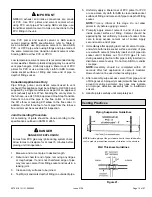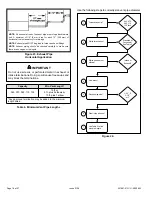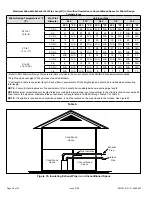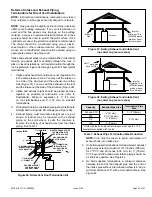
507961-01G / 31-5000653
Page 15 of 57
Issue 2128
NF96UV exhaust and intake connections are made
of PVC. Use PVC primer and solvent cement when
using PVC vent pipe. When using ABS vent pipe, use
transitional solvent cement to make connections to the
PVC fitting in the unit.
IMPORTANT
Use PVC primer and solvent cement or ABS solvent
cement meeting ASTM specifications, refer to Table 2.
As an alternate, use all purpose cement, to bond ABS,
PVC, or CPVC pipe when using fittings and pipe made of
the same materials. Use transition solvent cement when
bonding ABS to either PVC or CPVC.
Low temperature solvent cement is recommended during
cooler weather. Metal or plastic strapping may be used for
vent pipe hangers. Uniformly apply a liberal coat of PVC
primer for PVC or use a clean dry cloth for ABS to clean
inside socket surface of fitting and male end of pipe to
depth of fitting socket.
Canadian Applications Only
Pipe, fittings, primer and solvent cement used to vent
(exhaust) this appliance must be certified to ULC S636 and
supplied by a single manufacturer as part of an approved
vent (exhaust) system. When bonding the vent system to
the furnace, use ULC S636 approved One-Step Transition
Cement to bond the pipe to the flue collar, or to bond
the 90° elbow or reducing 90° elbow to the flue collar. In
addition, the first three feet of vent pipe from the furnace
flue collar must be accessible for inspection.
Joint Cementing Procedure
All cementing of joints should be done according to the
specifications outlined in ASTM D 2855.
DANGER OF EXPLOSION!
Fumes from PVC glue may ignite during system check.
Allow fumes to dissipate for at least 5 minutes before
placing unit into operation.
DANGER
1. Measure and cut vent pipe to desired length.
2. Debur and chamfer end of pipe, removing any ridges
or rough edges. If end is not chamfered, edge of pipe
may remove cement from fitting socket and result in a
leaking joint.
3. Clean and dry surfaces to be joined.
4.
Test fit joint and mark depth of fitting on outside of pipe.
5. Uniformly apply a liberal coat of PVC primer for PVC
or use a clean dry cloth for ABS to clean inside socket
surface of fitting and male end of pipe to depth of fitting
socket.
NOTE:
Time is critical at this stage. Do not allow
primer to dry before applying cement.
6. Promptly apply solvent cement to end of pipe and
inside socket surface of fitting. Cement should be
applied lightly but uniformly to inside of socket. Take
care to keep excess cement out of socket. Apply
second coat to end of pipe.
7. Immediately after applying last coat of cement to pipe,
and while both inside socket surface and end of pipe
are wet with cement, forcefully insert end of pipe into
socket until it bottoms out. Turn PVC pipe 1/4 turn
during assembly (but not after pipe is fully inserted) to
distribute cement evenly. Do not turn ABS or cellular
core pipe.
NOTE:
Assembly should be completed within 20
seconds after last application of cement. Hammer
blows should not be used when inserting pipe.
8. After assembly, wipe excess cement from pipe at end
of fitting socket. A properly made joint will show a bead
around its entire perimeter. Any gaps may indicate
an improper defective assembly due to insufficient
solvent.
9. Handle joints carefully until completely set.
Venting Practices
Piping Suspension Guidelines
NOTE:
Isolate piping at the point where it exits the outside wall or
roof in order to prevent transmission of vibration to the structure.
Wall Thickness Guidelines
Figure 21.
















































